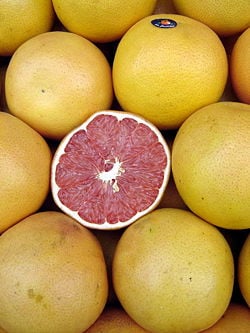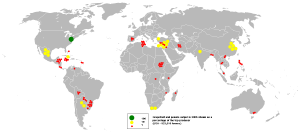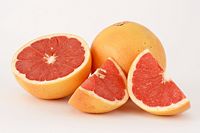Grapefruit
| Grapefruit | ||||||||||||||||
|---|---|---|---|---|---|---|---|---|---|---|---|---|---|---|---|---|
 Grapefruits
| ||||||||||||||||
| Scientific classification | ||||||||||||||||
| ||||||||||||||||
| Citrus paradisi Macfad. |
The grapefruit is a sub-tropical citrus tree grown for its fruit which was originally named the "forbidden fruit" of Barbados.[1]
Note:
Overview
All citrus trees are of the single genus Citrus and hybridize very easily. That is, there is only one "superspecies" which includes lemons, limes , grapefruit, pomelos, tangerines, and oranges.
Fruits of all members of the genus Citrus are considered berries because they have many seeds, are fleshy and soft, and derive from a single ovary. The distinctive fruit is a hesperidium in that it is a specialized berry with the internal fleshy parts divided into segments (typically 10 to 16) and surrounded by a separable rind (Katz and Weaver 2003). The citrus herperidium is globose to elongated, 4 to 30 centimeters long, and 4 to 20 centimeters in diameter. The rind is leathery and the segments, or "liths," are filled with pulp vesicles.
Citrus plants are small trees or large shrubs, reaching 5 to 15 meters tall, with spiny shoots and alternately arranged evergreen leaves with an entire margin. The flowers are solitary or in small corymbs (a branched cluster of flowers with lower flowers having longer stems). Each flower is 2 to 4 centimeters in diameter, with five (rarely four) white petals and numerous stamens; they are often very strongly scented.
The taxonomy of the genus is complex and the precise number of natural species is unclear, as many of the named species are clonally-propagated hybrids, and there is genetic evidence that even the wild, true-breeding species are of hybrid origin. Cultivated Citrus may be derived from as few as three or four ancestral species. Katz and Weaver (2003) claim that the generally accepted view is that there were three primordial Citrus species—Citrus medica (citrons), Citrus maxima (pumelos), and Citrus reticulata (mandarins)—and that all other types of citrus rose from single or sequential hybridization events between these species or their offspring. The hybridized types of citrus may or may not be recognized as species according to different taxonomies. Thus, anywhere from 3 to 170 species are recognized, with the commonly used system of Swingle recognizing 16 species (Katz and Weaver 2003).
Within a type of citrus, such as oranges, grapefruit, sour oranges, mandarins, and so forth, there are also recognized subtypes. For example, naval oranges, characterized by a small secondary fruit on one end of the main fruit, are one of four types of sweet oranges (Katz and Weaver 2003). (Again, these subtypes may or may not be recognized as separate species.)
Citrus is likely the most widely planted fruit for direct human consumption in the world (Katz and Weaver 2003).
These evergreen trees are usually found at around 5-6 m tall, although they can reach 13-15 m. The leaves are dark green, long (up to 150 mm) and thin. It produces 5 cm white four-petalled flowers. The fruit is yellow-skinned, largely oblate and ranges in diameter from 10-15 cm and has an acidic yellow segmented pulp. The numerous cultivars include the white grapefruit and the red, of which the 1929 US Ruby Red (of the Redblush variety) has a patent. The fruit has only become popular from the late 19th century; before that it was only grown as an ornamental plant. The US quickly became a major producer of the fruit, with orchards in Florida, Texas, Arizona, and California. In Spanish, the fruit is known as toronja or pomelo.
History
The fruit was first documented in 1750 by Rev. Griffith Hughes describing specimens from Barbados.[2] Currently, the grapefruit is said to be one of the "Seven Wonders of Barbados".[3] It had developed as a hybrid of the pomelo (Citrus maxima) with the sweet orange (Citrus sinensis), though it is closer to the former. It was brought to Florida by Odette Philippe in 1823. Further crosses have produced the tangelo (1905), the minneola (1931) and the sweetie (1984).
The grapefruit was known as the shaddock or shattuck until the 1800s. Its current name alludes to clusters of the fruit on the tree, which often appear similar to grapes. Botanically, it was not distinguished from the pomelo until the 1830s, when it was given the name Citrus paradisi. Its true origins were not determined until the 1940s. This led to the official name being altered to Citrus × paradisi.[4][5][6] Grapefruit peel oil is used in aromatherapy and it is historically known for its aromatic scent.[7]
Colors and flavors
Grapefruit comes in many varieties, determinable by color, which is caused by the pigmentation of the fruit in respect of both its state of ripeness and genetic bent.[8] The most popular varieties cultivated today are red, white, and pink hues, referring to the inside, pulp color of the fruit. The family of flavors range from highly acidic and somewhat bitter to sweet and tart.[8] Para-1-menthene-8-thiol, a sulfur-containing terpene, is one of the substances which has a strong influence on the taste and odour of grapefruit, compared with other citrus fruits.[9]
Drug interactions
Grapefruit can have a number of interactions with drugs, often increasing the effective potency of compounds. Grapefruit contains naringin, bergamottin and dihydroxybergamottin, which inhibit the cytochrome P450 isoform CYP3A4 in the intestine. It is via inhibition of this enzyme that grapefruit increases the effects of buspirone (Buspar), carbamazepine, several statin drugs (such as simvastatin), terfenadine, felodipine, nifedipine, verapamil, estradiol, tacrolimus, dextromethorphan (significant only at recreational doses), benzodiazepines, and ciclosporin.[10][11][12][13][14] The effect of grapefruit juice with regard to drug absorption was originally discovered in 1989. However, the effect became well-publicized after being responsible for a number of deaths due to overdosing on medication.[15]
Nutritional properties
Grapefruit is an excellent source of many nutrients and phytochemicals, for a healthy diet. Grapefruit is a good source of vitamin C,[8][16] pectin fiber,[17] and the pink and red hues contain the beneficial antioxidant lycopene.[8][18] Studies have shown grapefruit helps lower cholesterol[8][19] and there is evidence that the seeds have low levels of antioxidant properties.[20] Grapefruit forms a core part of the "grapefruit diet", the theory being that the fruit's low glycemic index is able to help the body's metabolism burn fat.[21]
Grapefruit seed extract has been claimed to be a strong antimicrobial with proven activity against bacteria and fungi. However, studies have shown the efficacy of grapefruit seed extract as an antimicrobial is not demonstrated. Although GSE is promoted as a highly effective plant-based preservative by some natural personal care manufacturers, studies indicate the universal antimicrobial activity associated with GSE preparations is merely due to contamination with synthetic preservatives.[22][23][24][25][26]
A 2007 study found a correlation between eating a quarter of grapefruit daily and a 30% increase in risk for breast cancer in post-menopausal women. The study points to the inhibition of CYP3A4 enzyme by grapefruit, which metabolizes estrogen.[27]
See also
- Grapefruit juice
- Grapefruit spoon
ReferencesISBN links support NWE through referral fees
- ↑ Morton, J. 1987. Grapefruit. p. 152–158. In: Fruits of warm climates. Julia F. Morton, Miami, FL. Forbidden Fruit Reference
- ↑ World Wide Words: Questions & Answers; Grapefruit. Abstract
- ↑ Barbados Seven Wonders: The Grapefruit Tree. Abstract
- ↑ Texas Citrus: Puzzling Beginnings. Article
- ↑ Grapefruit Family Tree: Origin of Red Grapefruit. Article
- ↑ University of Florida: IFAS Extension; The Grapefruit. Fact Sheet
- ↑ Ann Worwood, Valerie. The Complete Book of Essential Oils and Aromatherapy (Paperback). New World Library 1991. ISBN 0-93143-282-0
- ↑ 8.0 8.1 8.2 8.3 8.4 The World's Healthiest Foods; Grapefruit. The George Mateljan Foundation. Article
- ↑ A. Buettner, P. Schieberle (1999). Characterization of the Most Odor-Active Volatiles in Fresh, Hand-Squeezed Juice of Grapefruit (Citrus paradisi Macfayden). J. Agric. Food Chem. 47: 5189-5193.
- ↑ He K; Iyer KR; Hayes RN; Sinz MW; Woolf TF; Hollenberg PF. Inactivation of cytochrome P450 3A4 by bergamottin, a component of grapefruit juice. Chem Res Toxicol. 1998 Apr;11(4):252-9. Abstract
- ↑ Bailey DG, Malcolm J, Arnold O, Spence JD. Grapefruit juice-drug interactions. Br J Clin Pharmacol. 1998 Aug;46(2):101-10. Comment in: Br J Clin Pharmacol. 2001 Aug;52(2):216-7. Abstract
- ↑ Garg SK, Kumar N, Bhargava VK, Prabhakar SK. Effect of grapefruit juice on carbamazepine bioavailability in patients with epilepsy. Clin Pharmacol Ther. 1998 Sep;64(3):286-8. Abstract
- ↑ Bailey DG, Dresser GK. Interactions between grapefruit juice and cardiovascular drugs. Am J Cardiovasc Drugs. 2004;4(5):281-97. Abstract
- ↑ Bressler R. Grapefruit juice and drug interactions. Exploring mechanisms of this interaction and potential toxicity for certain drugs. Geriatrics. 2006 Nov;61(11):12-8. Abstract
- ↑ Bakalar, Nicholas. Experts Reveal the Secret Powers of Grapefruit Juice. New York Times. Published: March 21, 2006. Article
- ↑ Fellers PJ, Nikdel S, Lee HS. Nutrient content and nutrition labeling of several processed Florida citrus juice products. J Am Diet Assoc. 1990 Aug;90(8):1079-84. Abstract
- ↑ Cerda JJ, Robbins FL, Burgin CW, Baumgartner TG, Rice RW. The effects of grapefruit pectin on patients at risk for coronary heart disease without altering diet or lifestyle. Clin Cardiol. 1988 Sep;11(9):589-94. Abstract
- ↑ Lee HS. Objective measurement of red grapefruit juice color. J Agric Food Chem. 2000 May;48(5):1507-11. Abstract
- ↑ Platt R. Current concepts in optimum nutrition for cardiovascular disease. Prev Cardiol. 2000 Spring;3(2):83-87. Abstract
- ↑ Armando, C., Maythe, S., Beatriz, N. P. Antioxidant activity of grapefruit seed extract on vegetable oils. Journal of the Science of Food and Agriculture 1997 Dec;77(4):463-467. Abstract
- ↑ WMUR Ch. 9: New Hampshire news, weather, sports and entertainment. Researchers Put Grapefruit Diet To Test: Grapefruit Compound Lowers Cholesterol, Helps Regulate Insulin. June 11, 2003. Article
- ↑ Sakamoto S, Sato K, Maitani T, Yamada T. Analysis of components in natural food additive “grapefruit seed extract” by HPLC and LC/MS. Bull. Natl. Inst. Health Sci. 1996, 114:38–42. Abstract
- ↑ von Woedtke T, Schluter B, Pflegel P, Lindequist U, Julich WD. Aspects of the antimicrobial efficacy of grapefruit seed extract and its relation to preservative substances contained. Pharmazie 1999 54:452–456. Abstract
- ↑ Takeoka G, Dao L, Wong RY, Lundin R, Mahoney N. Identification of benzethonium chloride in commercial grapefruit seed extracts. J Agric Food Chem. 2001 49(7):3316–20. Abstract
- ↑ Takeoka GR, Dao LT, Wong RY, Harden LA. Identification of benzalkonium chloride in commercial grapefruit seed extracts. J Agric Food Chem. 2005 53(19):7630–6. Abstract
- ↑ Ganzera M, Aberham A, Stuppner H. Development and validation of an HPLC/UV/MS method for simultaneous determination of 18 preservatives in grapefruit seed extract. Institute of Pharmacy, University of Innsbruck, Innrain 52, 6020 Innsbruck, Austria. J Agric Food Chem. 2006 May 31;54(11):3768-72. Abstract
- ↑ Monroe, KR and Murphy SP, Kolonel LN, & Pike MC (2007). Prospective study of grapefruit intake and risk of breast cancer in postmenopausal women: the Multiethnic Cohort Study. (E-published before print; news article)
- Bender, D. A., and A. E. Bender. 2005. A Dictionary of Food and Nutrition. New York: Oxford University Press. ISBN 0198609612.
- Herbst, S. T. 2001. The New Food Lover's Companion: Comprehensive Definitions of Nearly 6,000 Food, Drink, and Culinary Terms. Barron's Cooking Guide. Hauppauge, NY: Barron's Educational Series. ISBN 0764112589.
- Katz, S. H., and W. W. Weaver. 2003. Encyclopedia of Food and Culture. New York: Schribner. ISBN 0684805685.
External links
- Graedon's Guide to Grapefruit Interactions.
- Grapefruit from "Fruits of warm climates" by Julia F. Morton.
- World's Northernmost Fruiting Grapefruit? in the Chelsea Physic Garden, London.
- Vegetarians in Paradise/Grapefruit History/Grapefruit Nutrition/Grapefruit Folklore/GrapefruitRecipe.
Credits
New World Encyclopedia writers and editors rewrote and completed the Wikipedia article in accordance with New World Encyclopedia standards. This article abides by terms of the Creative Commons CC-by-sa 3.0 License (CC-by-sa), which may be used and disseminated with proper attribution. Credit is due under the terms of this license that can reference both the New World Encyclopedia contributors and the selfless volunteer contributors of the Wikimedia Foundation. To cite this article click here for a list of acceptable citing formats.The history of earlier contributions by wikipedians is accessible to researchers here:
The history of this article since it was imported to New World Encyclopedia:
Note: Some restrictions may apply to use of individual images which are separately licensed.


